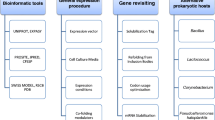Summary
One of the main challenges in this post genomic era is the development and implementation of efficient methods of protein synthesis. A clear understanding of the role of genes in an organism is to comprehend the biological functions of all of its proteins. Acquiring this knowledge will depend in part on the success of rapid synthesis and purification of proteins. The future of structural genomics and functional proteomics depends on the availability of abundantly expressing, soluble proteins in a high-throughput manner. Conventional cell based methods of protein expression is rather laborious, time consuming and the ways to fail are numerous including solubility, toxicity to the host and instability (e.g. proteolysis). Cell-free or in vitro protein synthesis, on the other hand allows the expression and analysis of protein synthesis, may solve many of these problems. It is a simple open system which lends itself for manipulations and modifications to influence protein folding, disulfide bond formation, incorporation of unnatural amino acids, protein stability (by incorporating protease inhibitors in the system) and even the expression of toxic proteins. Cell-free synthesis can also be used as a reliable screening methodology for subsequent protein expression in vivo. Furthermore, this technology is readily amenable to automation. Here, we present a protocol for expressing recombinant proteins with high yield in a standard 96-well plate format using E. coli cell-free extract in a batch mode.
Access this chapter
Tax calculation will be finalised at checkout
Purchases are for personal use only
Similar content being viewed by others
References
Zubay G (1973) In vitro synthesis of protein in microbial systems. Annu Rev Genet 7, 267–287.
Kim D-M and Swartz JR (1999) Prolonging cell-free protein synthesis with a novel ATP regeneration system. Biotechnol Bioeng 66, 180–188.
Kim D-M and Swartz JR (2000) Prolonging cell-free protein synthesis by selective reagent additions. Biotechnol Prog 16, 385–390.
Calhoun KA and Swartz JR (2005) An economical method for cell-free protein synthesis using glucose and nucleotide mono phosphates. Biotechnol Prog 21, 1146–1153.
Ryabova LA, Vinokurov LM, and Shekhovts-ova EA et al. (1995) Acetyl phosphate as an energy source for bacterial cell-free translation systems. Anal Biochem 226, 184–186.
Lesley SA, Brow MA, and Burgess RR (1991) Use of in vitro protein synthesis from polymerase chain reaction generated templates to study interaction of E. coli transcription factors with core RNA polymerase and for epitope mapping of monoclonal antibodies. J Biol Chem 266, 2632–2638.
Studier FW, Rosenberg AH, Dunn JJ, and Dubendorff JW (1990) Use of T7 RNA polymerase to direct expression of cloned genes. Methods Enzymol 185, 60–89.
Kudlicki W, Kramer G, and Hardesty B (1992) High efficiency cell-free synthesis of proteins: refinement of the coupled transcription/translation system. Anal Biochem 206, 389–393.
Sitaraman K, Esposito D, Klarmann G et al. (2004) A novel cell-free protein synthesis system. J Biotechnol 110, 257–263.
Kuem J-W, Kim T-W, Park C-G et al. (2006) Oxalate enhances protein synthesis in cell-free synthesis system utilizing 3-phos-phoglycerate as energy source. J Biosci Bio-eng 101(2), 162–165.
Hartley JL, Temple GF, and Brasch MA (2000) DNA cloning using in vitro site-specific recombination. Genome Res 10, 1788–1795.
Knaust RKC, Nordlund P (2001) Screening for soluble expression of recombinant proteins in a 96-well format. Anal Biochem 297, 79–85.
Shih Y-P, Kung W-M, Chen J-C et al. (2002) High throughput screening of soluble recombinant proteins. Protein Sci 11, 1714–1719.
Yokoyama S. (2003) Protein expression system for structural genomics and proteomics. Curr Opin Chem Biol 7, 39–43.
Busso D, Kim R, Kim S-H (2003) Expression of soluble recombinant proteins in a cell-free system using a 96-well format. J Biochem Biophys Methods 55, 233–240.
Betton J-M (2004) High throughput cloning and expression strategies for protein production. Biochimie 86, 601–605.
Acknowledgments
This project has been funded in whole or in part with federal funds from the National Cancer Institute, National Institutes of Health, under contract N01-CO-12400. The content of this publication does not necessarily reflect the views or policies of the Department of Health and Human Services, nor does mention of trade names, commercial products, or organizations imply endorsement by the U.S. Government.
Author information
Authors and Affiliations
Editor information
Editors and Affiliations
Rights and permissions
Copyright information
© 2009 Humana Press, a part of Springer Science+Business Media, LLC
About this protocol
Cite this protocol
Sitaraman, K., Chatterjee, D.K. (2009). High-Throughput Protein Expression Using Cell-Free System. In: Doyle, S.A. (eds) High Throughput Protein Expression and Purification. Methods in Molecular Biology, vol 498. Humana Press. https://doi.org/10.1007/978-1-59745-196-3_15
Download citation
DOI: https://doi.org/10.1007/978-1-59745-196-3_15
Publisher Name: Humana Press
Print ISBN: 978-1-58829-879-9
Online ISBN: 978-1-59745-196-3
eBook Packages: Springer Protocols




